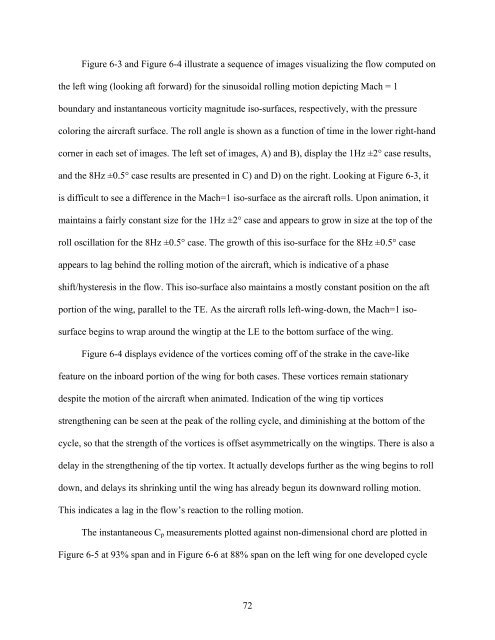university of florida thesis or dissertation formatting template
university of florida thesis or dissertation formatting template
university of florida thesis or dissertation formatting template
Create successful ePaper yourself
Turn your PDF publications into a flip-book with our unique Google optimized e-Paper software.
Figure 6-3 and Figure 6-4 illustrate a sequence <strong>of</strong> images visualizing the flow computed on<br />
the left wing (looking aft f<strong>or</strong>ward) f<strong>or</strong> the sinusoidal rolling motion depicting Mach = 1<br />
boundary and instantaneous v<strong>or</strong>ticity magnitude iso-surfaces, respectively, with the pressure<br />
col<strong>or</strong>ing the aircraft surface. The roll angle is shown as a function <strong>of</strong> time in the lower right-hand<br />
c<strong>or</strong>ner in each set <strong>of</strong> images. The left set <strong>of</strong> images, A) and B), display the 1Hz ±2° case results,<br />
and the 8Hz ±0.5° case results are presented in C) and D) on the right. Looking at Figure 6-3, it<br />
is difficult to see a difference in the Mach=1 iso-surface as the aircraft rolls. Upon animation, it<br />
maintains a fairly constant size f<strong>or</strong> the 1Hz ±2° case and appears to grow in size at the top <strong>of</strong> the<br />
roll oscillation f<strong>or</strong> the 8Hz ±0.5° case. The growth <strong>of</strong> this iso-surface f<strong>or</strong> the 8Hz ±0.5° case<br />
appears to lag behind the rolling motion <strong>of</strong> the aircraft, which is indicative <strong>of</strong> a phase<br />
shift/hysteresis in the flow. This iso-surface also maintains a mostly constant position on the aft<br />
p<strong>or</strong>tion <strong>of</strong> the wing, parallel to the TE. As the aircraft rolls left-wing-down, the Mach=1 iso-<br />
surface begins to wrap around the wingtip at the LE to the bottom surface <strong>of</strong> the wing.<br />
Figure 6-4 displays evidence <strong>of</strong> the v<strong>or</strong>tices coming <strong>of</strong>f <strong>of</strong> the strake in the cave-like<br />
feature on the inboard p<strong>or</strong>tion <strong>of</strong> the wing f<strong>or</strong> both cases. These v<strong>or</strong>tices remain stationary<br />
despite the motion <strong>of</strong> the aircraft when animated. Indication <strong>of</strong> the wing tip v<strong>or</strong>tices<br />
strengthening can be seen at the peak <strong>of</strong> the rolling cycle, and diminishing at the bottom <strong>of</strong> the<br />
cycle, so that the strength <strong>of</strong> the v<strong>or</strong>tices is <strong>of</strong>fset asymmetrically on the wingtips. There is also a<br />
delay in the strengthening <strong>of</strong> the tip v<strong>or</strong>tex. It actually develops further as the wing begins to roll<br />
down, and delays its shrinking until the wing has already begun its downward rolling motion.<br />
This indicates a lag in the flow’s reaction to the rolling motion.<br />
The instantaneous Cp measurements plotted against non-dimensional ch<strong>or</strong>d are plotted in<br />
Figure 6-5 at 93% span and in Figure 6-6 at 88% span on the left wing f<strong>or</strong> one developed cycle<br />
72
















